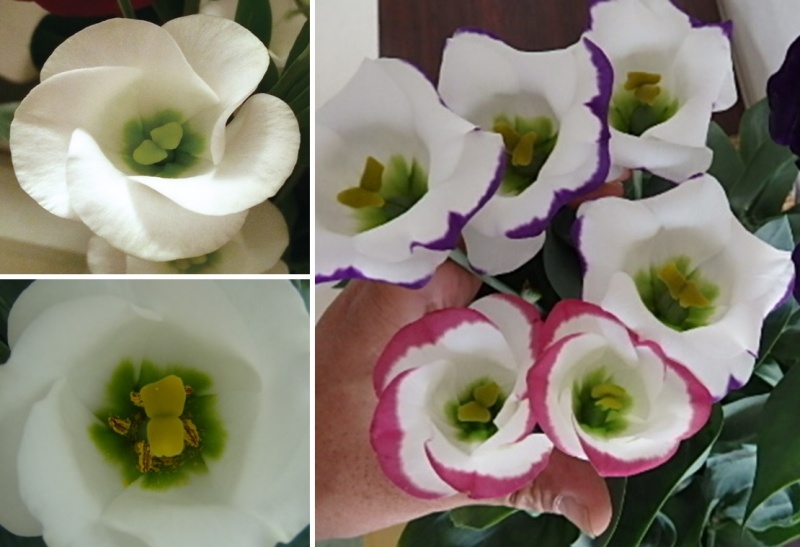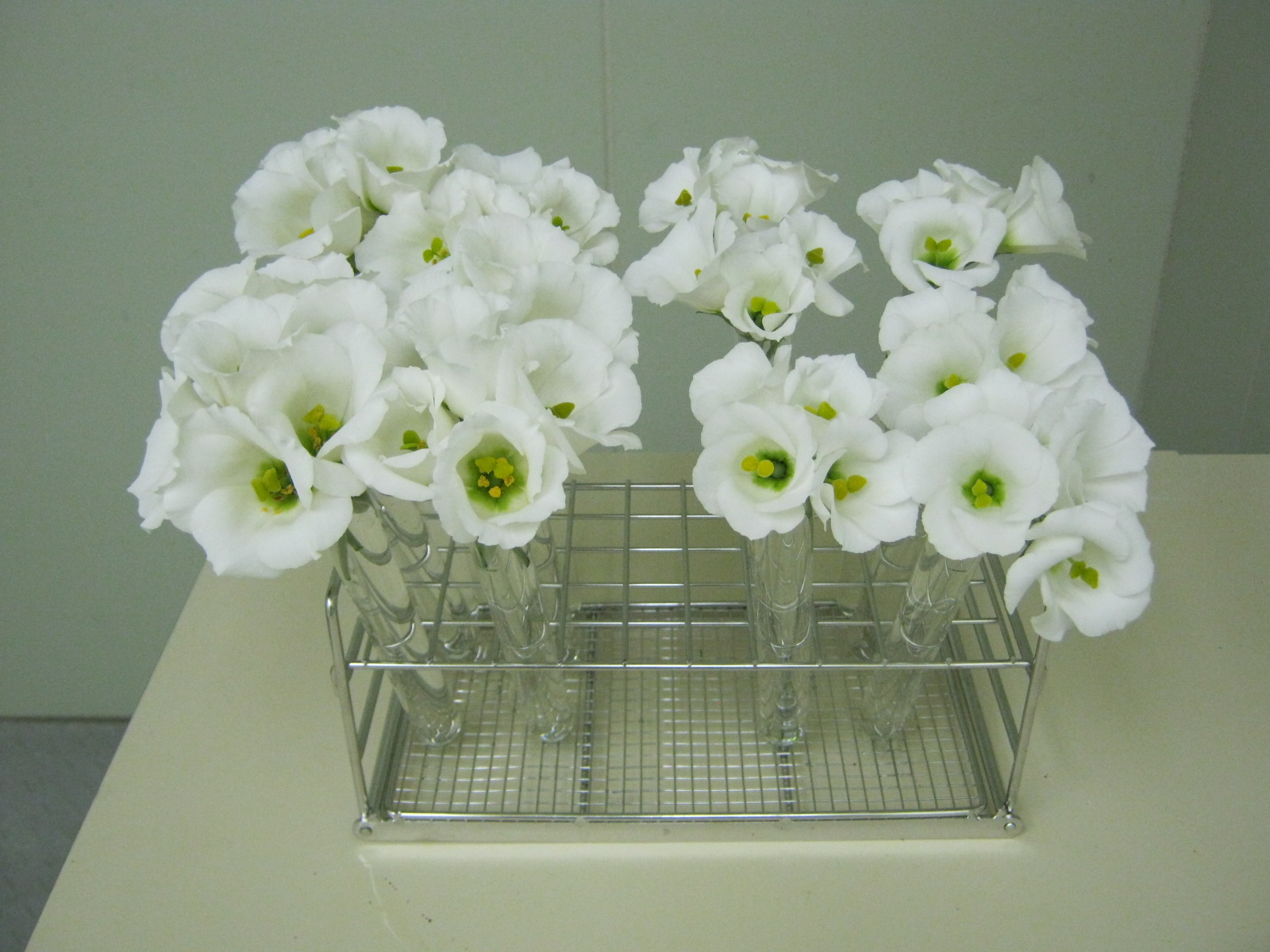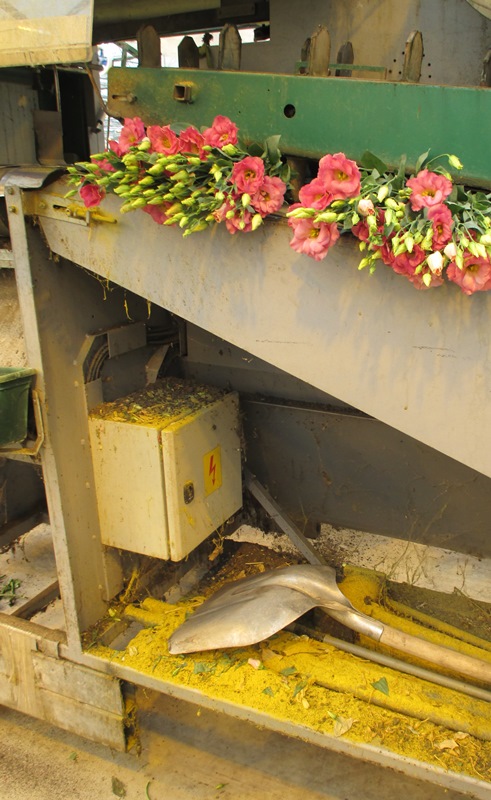Sakata Seed Corporation has taken Lisianthus breeding to a new stage, with the development of the world’s first Lisianthus type that does not produce pollen.

Right and above Left is pollen-free type, below Left are conventional varieties.
With no stamen to produce pollen*1, Sakata’s revolutionary new Lisianthus varieties have excellent flower durability and the benefit of no scattered pollen that can cause staining of flowers, machines and home décor. The pollen-free flower type is common among cut flowers such as Sunflower, however this is a world’s first in Lisianthus, a cut flower with increasing popularity and spectacular market growth. With the development of this new technology (Patent Pending), Sakata foresees an even greater expansion of the popularity of Lisianthus in the future.
There are two major benefits to pollen free Lisianthus cut flower. The first one is that during transportation shaking will not cause pollen to scatter, thus the petals stay clean and are not smeared with pollen. Secondly, the absence of pollination can mean an ever longer vase life for the flowers. In studies carried out by Sakata and other companies (see the graph on the next page), the decorative vase life of the flowers has been found to last for about 7 days longer than conventional Lisianthus varieties, presenting an opportunity for even higher commercial value. These combined features will be of great advantage during longer transportation periods, such as during import and export of Lisianthus cut flowers, and we believe this offers a significant advantage over the current market assortment.
Initially, Sakata has developed three varieties: Single-flowered White, Single-flowered Blue Picotee, and Single-flowered Pink Picotee. Seed sales of these three varieties is scheduled for test marketing in Japan is the fall of 2017. Research of a Double-flowered type is also underway and we plan to announce this release in the future. These varieties result from the innovative and technological strength of Sakata’s Flower Research team – pioneers of Lisianthus development. Sakata is currently the top market-share holder in Lisianthus
Revolutionary quality of flower durability achieved through pollen-free technology
One of the merits of the pollen-free type is the fact that it increases the flower durability. One of the reasons for decreased vase life of cut flowers is pollination, which results from the physiological characteristics of the plant. The pollen-free type does not produce any pollen and therefore cannot pollinate, which improves its longevity. Vase life tests performed by Sakata, and other companies in the market, show that the pollen-free type shows very good performance. This characteristic is displayed most strongly during the summer months when the temperature is high and flower durability tends to be decreased. The newly developed pollen-free type is ideal for shipping in the summer season, characterized by a high demand for cut flowers, and can give consumers the opportunity to enjoy Lisianthus cut flowers for a much longer period.
Vase-life tests for the pollen-free type and the conventional varieties
Test overview: Tests were carried out with pollen-free types and conventional varieties. Lisianthus flowers blooming on the same day in the same field were picked and the stem reduced to 4 cm in length. Forced pollination was applied to the conventional varieties, assuming there will be shaking during transportation. We counted the days passed since the flower petals started wilting and withering.
-
*
Research by the Misato Research Station (Sakata Seed Corporation, Japan)

Graph of the vace life test
Test results
Compared to conventional varieties (forced-pollinated), the flowering performance of the pollen-free varieties lasted about 7 days longer.

The vase life test: Left is conventional variety. Right is pollen-free variety.
Pollen-free varieties provide benefits in production, at auction, at retail, and in the consumer’s home.
In large-scale facility cultivation in The Netherlands, growers harvested more than ten thousand Lisianthus cut flowers in one day, and moved them using transportation bands and binding machines. If they use a conventional variety, pollen is scattered around. Many times, pollen will cause the flowers to stain yellow. Removing stained flowers is a burden for growers. Pollen-free varieties will free the growers from extra work and, furthermore, reduce the shipping loss.
In addition, good vase life performance is welcomed by the florist and other retail stores. At home, pollen-free varieties will be beneficial in the decor of the dining table, because there is no fear that pollen will fall on the linnen or in the food. Pollen-free varieties provide benefits in production, at auction, at retail, and in the consumer’s home.

Binding machine that stained by Lisianthus pollen
Development of the pollen-free type and its potential as a cut flower
Sunflower (Helianthus annuus ) is a famous example of how the commercial value has increased with the introduction of pollen-free varieties. Currently, Sunflower cut flowers are almost all pollen free. Previously, Sunflowers were not popular as cut flowers, because they were messy and dropped pollen on the table. Moreover, they were quick to wilt and vase-life performance was poor. When SAKATA SEED CORPORATION developed the F1 variety "Kagayaki" in 1986 it was the world’s first pollen-free Sunflower and they become popular as cut flowers. Not stopping at the traditional demand for Sunflowers in the garden, Sakata created a trailblazer in the cut flower world, and as such, were able to position what can be only regarded as a new classic at the florists. In this way, the pollen-free type might contribute to the expansion of the market for all commercial varieties.
Logo for the pollen free type of Lisianthus (Trademark registration pending)
-
Pollen Free
-
Prolonged Flowering
-
Patented Flower Breeding Technology
We created the logo using the combination of the “P” and “F” initials from the above three words. It will be used for the pollen-free type of Lisianthus, which our company is going to sell in the future.

-
*
1 Stamen is incomplete: There are cases when incomplete stamens are formed due to cultivation environment, however the pollen generated by incomplete stamens has extremely small amount and nearly no impact on the flower durability.